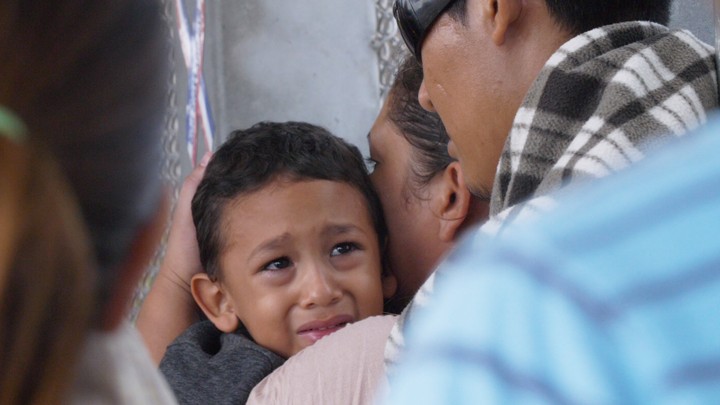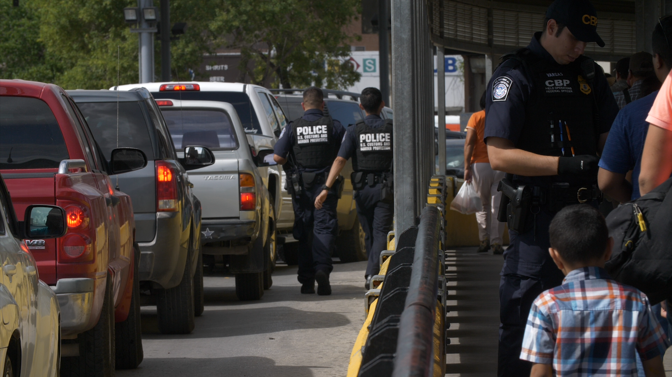Purgatory at the Border
Jeremy Raff, The Atlantic,
Jun 19, 2018
Families
fleeing gang violence are stuck at a pedestrian bridge between the U.S. and
Mexico. They’re hungry, exhausted, and scared for their lives.
fleeing gang violence are stuck at a pedestrian bridge between the U.S. and
Mexico. They’re hungry, exhausted, and scared for their lives.
 |
| A mother and child from southern Mexico learn that agents have delayed their bid to enter the United States and request asylum. Jeremy Raff |
MATAMOROS,
Mexico—When drug traffickers shot Wayner Berduo seven times last year, they
didn’t stop there. The men nearly beat him to death with their pistol grips,
police reports say. One bullet pierced Berduo’s eye socket, so after the
attack, surgeons removed his left eye and stitched back together his face and
his right arm, which now hangs limply by his side.
For days,
Berduo has waited hours at a time in the long line of day-trippers, shoppers,
and commuters headed for Brownsville, Texas. When I met him, he was clutching a
plastic bag of medications he hoped to bring with him—if the agents at the
front of the line ever allowed him to legally enter the U.S. to apply for
asylum protection. So far, they have not.
Berduo has waited hours at a time in the long line of day-trippers, shoppers,
and commuters headed for Brownsville, Texas. When I met him, he was clutching a
plastic bag of medications he hoped to bring with him—if the agents at the
front of the line ever allowed him to legally enter the U.S. to apply for
asylum protection. So far, they have not.
Like
hundreds of others stuck at the
border in recent weeks,
Berduo stands in a kind of purgatory spanning the Rio Grande. Agents have
repeatedly turned him around, telling him to “wait in Mexico” and check back
every few hours. I watched as they turned him back for the 20th time in four
days, the agents explaining that they didn’t have enough room in the port of entry
to process Berduo.
hundreds of others stuck at the
border in recent weeks,
Berduo stands in a kind of purgatory spanning the Rio Grande. Agents have
repeatedly turned him around, telling him to “wait in Mexico” and check back
every few hours. I watched as they turned him back for the 20th time in four
days, the agents explaining that they didn’t have enough room in the port of entry
to process Berduo.
The
United States government has separated more than
2,300 children from their parents at the border since May, a tactic
that top officials in the Trump administration have described as a form of
deterrence. Delaying asylum seekers on the bridge appears to be part of this
larger effort. Fleeing dangerous conditions to seek refuge in America is
getting more difficult for people like Wayner. Last week, Attorney General Jeff
Sessions overturned more than a decade of jurisprudence
to rule that asylum claims based on gang violence or domestic abuse generally
will not qualify.
United States government has separated more than
2,300 children from their parents at the border since May, a tactic
that top officials in the Trump administration have described as a form of
deterrence. Delaying asylum seekers on the bridge appears to be part of this
larger effort. Fleeing dangerous conditions to seek refuge in America is
getting more difficult for people like Wayner. Last week, Attorney General Jeff
Sessions overturned more than a decade of jurisprudence
to rule that asylum claims based on gang violence or domestic abuse generally
will not qualify.
The Trump
administration encourages migrants to seek asylum at bridges—“You are not
breaking the law by seeking asylum at a port of entry,” Homeland Security
Secretary Kirstjen Nielsen tweeted
Sunday—even as it has made it more difficult for them to do so.
administration encourages migrants to seek asylum at bridges—“You are not
breaking the law by seeking asylum at a port of entry,” Homeland Security
Secretary Kirstjen Nielsen tweeted
Sunday—even as it has made it more difficult for them to do so.
I grew up
here in the Rio Grande Valley, and on this trip back home, I noticed a new
feature of cross-border pedestrian travel. Border agents used to check
documents once travelers reached an air-conditioned office on the Texas bank of
the river. Now, agents stand in the precise middle of the bridge, careful to
hold the imaginary line that bisects the Rio Grande. A small plaque marks the
international boundary there, and the concrete underfoot changes from the
textured Mexican variety to smooth American. Under U.S. law, asylum seekers
have the right to
ask for protection once they’re on U.S. soil, so if they cross the
line, border guards are obligated to process them. Last week, journalist Debbie
Nathan documented
a father and son being admitted after repeated denials when the pair took a
small but important step into the United States—but only after border guards
became “flustered” by her presence filming the encounter and stepped backward
into the U.S.
here in the Rio Grande Valley, and on this trip back home, I noticed a new
feature of cross-border pedestrian travel. Border agents used to check
documents once travelers reached an air-conditioned office on the Texas bank of
the river. Now, agents stand in the precise middle of the bridge, careful to
hold the imaginary line that bisects the Rio Grande. A small plaque marks the
international boundary there, and the concrete underfoot changes from the
textured Mexican variety to smooth American. Under U.S. law, asylum seekers
have the right to
ask for protection once they’re on U.S. soil, so if they cross the
line, border guards are obligated to process them. Last week, journalist Debbie
Nathan documented
a father and son being admitted after repeated denials when the pair took a
small but important step into the United States—but only after border guards
became “flustered” by her presence filming the encounter and stepped backward
into the U.S.
 |
| Under U.S. law, asylum seekers have the right to ask for protection once they’re on U.S. soil. Guards used to check documents on the Texas bank of the river. Now, they stand directly on the international boundary. (Jeremy Raff) |
Back in
Matamoros, Wayner and his family—his 11-year-old brother, Elian, and his
mother, Estefania—have been sleeping on the ground at the foot of the bridge
for several nights. “It’s dangerous where we are in Mexico,” Elian says, “we
can’t go far” from the bridge. He is glum and antsy, so Estefania walks him to
a nearby corner store to buy a coke. They live off donations from people stuck
in sweltering cars waiting to get through customs. “They sell meat here, but we
can’t afford it,” Elian says. “We barely eat anymore.”
Matamoros, Wayner and his family—his 11-year-old brother, Elian, and his
mother, Estefania—have been sleeping on the ground at the foot of the bridge
for several nights. “It’s dangerous where we are in Mexico,” Elian says, “we
can’t go far” from the bridge. He is glum and antsy, so Estefania walks him to
a nearby corner store to buy a coke. They live off donations from people stuck
in sweltering cars waiting to get through customs. “They sell meat here, but we
can’t afford it,” Elian says. “We barely eat anymore.”
Another
brother sent Elian a voice message, trying to sound encouraging. “Don’t be
scared, and don’t leave Mom’s side,” he said. “Don’t get separated from her.”
brother sent Elian a voice message, trying to sound encouraging. “Don’t be
scared, and don’t leave Mom’s side,” he said. “Don’t get separated from her.”
If Elian
and Estefania lose patience and attempt a river crossing, they risk being
separated under President Trump’s “zero tolerance” policy. If they stick to the
bridge, they should have a better chance of staying together, although there
are reports of asylum seekers who entered legally still being separated from
their children.
and Estefania lose patience and attempt a river crossing, they risk being
separated under President Trump’s “zero tolerance” policy. If they stick to the
bridge, they should have a better chance of staying together, although there
are reports of asylum seekers who entered legally still being separated from
their children.
I stood
with Wayner as agents checked IDs up ahead, and he inched forward on the
bridge. He’d followed instructions agents gave him that morning almost to the
minute: Return at 4 p.m. and try again, they had said. Still, the officers
turned him down. When I asked why, they brought out a supervisor who referred
me to a spokesperson who declined to comment. An email the spokesman forwarded
said the wait times are a product of balancing different responsibilities.
with Wayner as agents checked IDs up ahead, and he inched forward on the
bridge. He’d followed instructions agents gave him that morning almost to the
minute: Return at 4 p.m. and try again, they had said. Still, the officers
turned him down. When I asked why, they brought out a supervisor who referred
me to a spokesperson who declined to comment. An email the spokesman forwarded
said the wait times are a product of balancing different responsibilities.
That day,
Wayner stood next to an asylum-seeking woman from a cartel-riven area of
southern Mexico. Agents denied her too, and her child’s face crumpled.
Wayner stood next to an asylum-seeking woman from a cartel-riven area of
southern Mexico. Agents denied her too, and her child’s face crumpled.
The
following day, border guards did allow the Berduo family into the U.S. to make
their asylum claim, relatives told me. But because of the Sessions ruling on
June 11—the day the Berduos arrived at the Matamoros bridge—their asylum claim
may ultimately fail.
following day, border guards did allow the Berduo family into the U.S. to make
their asylum claim, relatives told me. But because of the Sessions ruling on
June 11—the day the Berduos arrived at the Matamoros bridge—their asylum claim
may ultimately fail.


